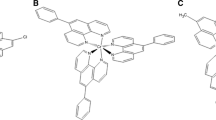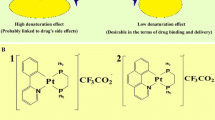Abstract
A new synthetic route to acquire the water soluble complex fac-ReI(CO)3(pterin)(H2O) was carried out in aqueous solution. The complex has been obtained with success via the fac-[ReI(CO)3(H2O)3]Cl precursor complex. ReI(CO)3(pterin)(H2O) has been found to bind strongly with bovine and human serum albumins (BSA and HSA) with intrinsic-binding constants, Kb, of 6.5 × 105 M−1 and 5.6 × 105 M−1 at 310 K, respectively. The interactions of serum albumins with ReI(CO)3(pterin)(H2O) were evaluated employing UV–vis fluorescence and absorption spectroscopy and circular dichroism. The results suggest that the serum albumins-ReI(CO)3(pterin)(H2O) interactions occurred in the domain IIA-binding pocket without loss of helical stability of the proteins. The comparison of the fluorescence quenching of BSA and HSA due to the binding to the Re(I) complex suggested that local interaction around the Trp 214 residue had taken place. The analysis of the thermodynamic parameters ΔG0, ΔH0, and ΔS0 indicated that the hydrophobic interactions played a major role in both HSA-Re(I) and BSA-Re(I) association processes. All these experimental results suggest that these proteins can be considered as good carriers for transportation of ReI(CO)3(pterin)(H2O) complex. This is of significant importance in relation to the use of this Re(I) complex in several biomedical fields, such as photodynamic therapy and radiopharmacy.






Similar content being viewed by others
References
Leonidova A, Gasser G (2014) Underestimated potential of organometallic rhenium complexes as anticancer agents. ACS Chem Biol 9:2180–2193. doi:10.1021/cb500528c
Navarro M, Castro W, Biot C (2012) Bioorganometallic compounds with antimalarial targets: inhibiting hemozoin formation. Organometallics 31:5715–5727. doi:10.1021/om300296n
Giordano PJ, Fredricks SM, Wrighton MS, Morse DL (1978) Simultaneous multiple emissions from fac-XRe(C0)3(3-benzoylpyridine)2: n-r* intraligand and charge-transfer emission at low temperature. J Am Chem Soc 100:2257. doi:10.1021/ja00475a061
Kumar A, Sun S, Lees AJ (2010) Photophysics and photochemistry of organometallic rhenium diimine complexes. Top Organomet Chem. doi:10.1007/3418
Ragone F, Martinez Saavedra HH, David Gara PM et al (2013) Photosensitized generation of singlet oxygen from Re(I) complexes: a photophysical study using LIOAS and luminescence techniques. J Phys Chem A 117:4428–4435. doi:10.1021/jp402550g
Ruiz GT, Ferraudi G, Wolcan E, Feliz MR (2010) On the elusive, non-emissive yet reactive, upper excited states of [(4,40-bpy)ReI(CO)3(dppz)]PF6 (dppz = dipyridil[3,2-a:2030-c]phenazine). Inorg Chem Acta. doi:10.1016/j.ica.2010.01.033
Lo KK-W, Choi AW-T, Law WH-T (2012) Applications of luminescent inorganic and organometallic transition metal complexes as biomolecular and cellular probes. Dalt Trans 41:6021. doi:10.1039/c2dt11892k
Lo KKW (2015) Luminescent rhenium(I) and iridium(III) polypyridine complexes as biological probes, imaging reagents, and photocytotoxic agents. Acc Chem Res 48:2985–2995. doi:10.1021/acs.accounts.5b00211
Morais GR, Paulo A, Santos I (2012) Organometallic complexes for SPECT imaging and/or radionuclide therapy. Organometallics 31:5693–5714. doi:10.1021/om300501d
Mjos KD, Orvig C (2014) Metallodrugs in medicinal inorganic chemistry. Chem Rev 114:4540–4563. doi:10.1021/cr400460s
Peters T (1985) Serum albumin. Adv Protein Chem 37:161–245. doi:10.1016/S0065-3233(08)60065-0
Bertucci C, Domenici E (2002) Reversible and covalent binding of drugs to human serum albumin: methodological approaches and physiological relevance. Curr Med Chem 9:1463–1481
Deepa S, Mishra AK (2005) Fluorescence spectroscopic study of serum albumin-bromadiolone interaction: fluorimetric determination of bromadiolone. J Pharm Biomed Anal 38:556–563. doi:10.1016/j.jpba.2005.01.023
Xie MX, Xu XY, Wang YD (2005) Interaction between hesperetin and human serum albumin revealed by spectroscopic methods. Biochim Biophys Acta Gen Subj 1724:215–224. doi:10.1016/j.bbagen.2005.04.009
Steinhardt J, Krijn J, Leidy JG (1971) Differences between bovine and human serum albumins: binding isotherms, optical rotatory dispersion, viscosity, hydrogen ion titration, and fluorescence effects. Biochemistry 10:4005–4015. doi:10.1021/bi00798a001
Carter DC, Ho JX (1994) Structure of serum albumins. Adv Protein Chem 45:153–203. doi:10.1016/S0065-3233(08)60640-3
Bhuvaneswari J, Mareeswaran PM, Anandababu K, Rajagopal S (2014) The switching of a Rhenium(I) complex from turn-off to turn-on sensor system through protein binding. RSC Adv 4:34659. doi:10.1039/C4RA05464D
Bhuvaneswari J, Fathima AK, Rajagopal S (2012) Rhenium(I)-based fluorescence resonance energy transfer probe for conformational changes of bovine serum albumin. J Photochem Photobiol A Chem 227:38–44. doi:10.1016/j.jphotochem.2011.10.022
Bhuvaneswari J, Mareeswaran PM, Shanmugasundaram S, Rajagopal S (2011) Protein binding studies of luminescent rhenium(I) diimine complexes. Inorganica Chim Acta 375:205–212. doi:10.1016/j.ica.2011.05.009
Ragone F, Ruiz GT, Piro OE et al (2012) Water-soluble (Pterin)rhenium(I) complex: synthesis, structural characterization, and two reversible protonation-deprotonation behavior in aqueous solutions. Eur J Inorg Chem 2012:4801–4810. doi:10.1002/ejic.201200681
Ruiz GT, Juliarena MP, Lezna RO et al (2007) Intercalation of fac-[(4,4′-bpy)ReI(CO)3(dppz)] + , dppz = dipyridyl[3,2-a:2′3′-c]phenazine, in polynucleotides. On the UV-vis photophysics of the Re(I) intercalator and the redox reactions with pulse radiolysis-generated radicals. Dalton Trans 3:2020–2029. doi:10.1039/b614970g
Toneatto J, Garcia PF, Argüello Ga (2011) Advances on the interaction of polypyridyl Cr(III) complexes with transporting proteins and its potential relevance in photodynamic therapy. J Inorg Biochem 105:1299–1305. doi:10.1016/j.jinorgbio.2011.07.013
Lakowicz JR (2006) Principles of Fluorescence Spectroscopy, 3rd edn. doi: 10.1007/978-0-387-46312-4
Ryan DK, Weber JH (1982) Fluorescence quenching titration for determination of complexing capacities and stability constants of fulvic acid. Anal Chem 54:986–990. doi:10.1021/ac00243a033
Van De Weert M, Stella L (2011) Fluorescence quenching and ligand binding: a critical discussion of a popular methodology. J Mol Struct 998:145–150. doi:10.1016/j.molstruc.2011.05.023
Li Y, He W, Liu J et al (2005) Binding of the bioactive component Jatrorrhizine to human serum albumin. Biochim Biophys Acta Gen Subj 1722:15–21. doi:10.1016/j.bbagen.2004.11.006
Molina-Bolívar JA, Galisteo-González F, Carnero Ruiz C et al (2015) Interaction between the anti-cancer drug diacetyl maslinic acid and bovine serum albumin: a biophysical study. J Mol Liq 208:304–313. doi:10.1016/j.molliq.2015.04.050
Woody RW (1996) Circular dichroism and the conformational analysis of biomolecules. doi: 10.1007/978-1-4757-2508-7_2
Sun C, Yang J, Wu X et al (2005) Unfolding and refolding of bovine serum albumin induced by cetylpyridinium bromide. Biophys J 88:3518–3524. doi:10.1529/biophysj.104.051516
Toneatto J, Argüello Ga (2011) New advances in the study on the interaction of [Cr(phen)2(dppz)]3+ complex with biological models; association to transporting proteins. J Inorg Biochem 105:645–651. doi:10.1016/j.jinorgbio.2010.10.018
Lazarova N, James S, Babich J, Zubieta J (2004) A convenient synthesis, chemical characterization and reactivity of [Re(CO)3(H2O)3]Br: the crystal and molecular structure of [Re(CO)3(CH3CN)2Br]. Inorg Chem Commun 7:1023–1026. doi:10.1016/j.inoche.2004.07.006
Ragone F (2015) Estudios fotoquimicos y fotofisicos en complejos tricarbonilicos de Renio(I) y su interaccion con biopólimeros. PhD Thesis UNLP
Ross PD, Subramanian S (1981) Thermodynamics of protein association reactions: forces contributing to stability. Biochemistry 20:3096–3102. doi:10.1021/bi00514a017
Mallick a, Haldar B, Chattopadhyay N (2005) Spectroscopic investigation on the interaction of ICT probe 3-acetyl-4-oxo-6,7-dihydro-12H indolo- 2,3-a quinolizine with serum albumins. J Phys Chem B 109:14683–14690. doi:10.1021/jp051367z
Liu J, Tian J, He W et al (2004) Spectrofluorimetric study of the binding of daphnetin to bovine serum albumin. J Pharm Biomed Anal 35:671–677. doi:10.1016/j.jpba.2004.02.010
Busetti A, Soncin M, Jori G, Rodgers M (1999) High efficiency of benzoporphyrin derivative in the photodynamic therapy of pigmented malignant melanoma. Br J Cancer 79:821–824. doi:10.1038/sj.bjc.6690131
Narazaki R, Harada K, Sugii A, Otagiri M (1997) Kinetic analysis of the covalent binding of captopril to human serum albumin. J Pharm Sci 86:215–219. doi:10.1021/js960234+
Thomas AH, Lorente C, Roitman K et al (2013) Photosensitization of bovine serum albumin by pterin: a mechanistic study. J Photochem Photobiol B Biol 120:52–58. doi:10.1016/j.jphotobiol.2013.01.008
Alberto R, Schibli R, Waibel R (1999) Basic aqueous chemistry of +(M=Re, Tc) directed towards radiopharmaceutical application. Coord Chem Rev 192:901–919
Acknowledgements
This work was supported by CONICET (PIP 0389), ANPCyT (PICT 2010-1435), and Universidad Nacional de La Plata (UNLP 11/X611) of Argentina. FR and GTR thank Dr. Croce (INIFTA, UNLP, Argentina) for their assistance in FTIR measurements. HHMS thanks to CCT-La Plata and CCT-Córdoba from CONICET for his Fellowship in the Funding Program to Short Visit to INFIQC. FR, HHMS, and PFG thank CONICET for research scholarships. EW, GAA, and GTR are Research Members of CONICET (Argentina).
Author information
Authors and Affiliations
Corresponding author
Additional information
F. Ragone, H. H. M. Saavedra, P. F. García contributed equally to the experimental part of this work.
Electronic supplementary material
Below is the link to the electronic supplementary material.
Rights and permissions
About this article
Cite this article
Ragone, F., Saavedra, H.H.M., García, P.F. et al. Association studies to transporting proteins of fac-ReI(CO)3(pterin)(H2O) complex. J Biol Inorg Chem 22, 99–108 (2017). https://doi.org/10.1007/s00775-016-1410-7
Received:
Accepted:
Published:
Issue Date:
DOI: https://doi.org/10.1007/s00775-016-1410-7




